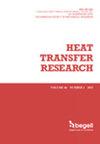填充率和纤维素纳米纤维纳米流体对总热阻和微型热流器启动的影响
IF 1.6
4区 工程技术
Q3 THERMODYNAMICS
引用次数: 0
摘要
本研究通过实验研究了填充率和纤维素纳米纤维(CNF)纳米流体浓度对铜制微型两相封闭热流器(TPCT)在不同热负荷下的总热阻和启动的影响。设备长度为 340 毫米,内径为 10 毫米,厚度为 1 毫米。工作流体为去离子水(DI)和体积分数为 0.5、1 和 2% 的 CNF 悬浮液,填充率分别为 25、50 和 75%。冷却系统采用强制空气对流。TPCT 的总热阻是根据每次实验稳定状态下壁温分布的记录数据得出的。在填充率为 75% 的 DI 中添加 1 体积分数的 CNF 后,蒸发器壁温分别降低了 40% 和 23%,在 20W 和 80W 条件下,总热阻分别降低了 58.78% 和 33.65%。此外,它还将启动时间缩短了 33%,温度降低了 42%。本文包含的重要研究结果证明,当采用适当的浓度和填充比例时,氯化萘纤维可提高 TPCT 的热性能。本文章由计算机程序翻译,如有差异,请以英文原文为准。
Impact of filling ratio and cellulose nanofiber nanofluid on the total thermal resistance and the startup of a miniature thermosyphon
The influence of filling ratio and cellulose nanofiber (CNF) nanofluid concentration on the total thermal resistance and the startup of a copper miniature two-phase closed thermosyphon (TPCT) at various heat loads are investigated experimentally in this study. Length of the device is 340 mm with inner diameter of 10 mm and 1 mm of thickness. The working fluids are deionized water (DI) and CNF suspensions with 0.5, 1 and 2 vol. % and filling ratios were set to 25, 50 and 75%. Heat load varied from 20 W to 80 W with increment of 10 W. Cooling system adopted the forced air convection. Total thermal resistance of the TPCT was obtained using the recorded data of wall temperature distribution at the steady state of each experiment. Addition of CNF with 1 vol. % to DI at filling ratio of 75% reduced the evaporator wall temperature by 40% and 23%, also it reduced the total thermal resistance by 58.78% and 33.65% at 20 and 80W, respectively. Moreover, it shortened the startup duration by 33% and reduced its temperature by 42%. This paper contains important findings that proves that CNF enhanced the thermal performance of the TPCT when applying an appropriate concentration and filling ratio.
求助全文
通过发布文献求助,成功后即可免费获取论文全文。
去求助
来源期刊

Heat Transfer Research
工程技术-热力学
CiteScore
3.10
自引率
23.50%
发文量
102
审稿时长
13.2 months
期刊介绍:
Heat Transfer Research (ISSN1064-2285) presents archived theoretical, applied, and experimental papers selected globally. Selected papers from technical conference proceedings and academic laboratory reports are also published. Papers are selected and reviewed by a group of expert associate editors, guided by a distinguished advisory board, and represent the best of current work in the field. Heat Transfer Research is published under an exclusive license to Begell House, Inc., in full compliance with the International Copyright Convention. Subjects covered in Heat Transfer Research encompass the entire field of heat transfer and relevant areas of fluid dynamics, including conduction, convection and radiation, phase change phenomena including boiling and solidification, heat exchanger design and testing, heat transfer in nuclear reactors, mass transfer, geothermal heat recovery, multi-scale heat transfer, heat and mass transfer in alternative energy systems, and thermophysical properties of materials.
 求助内容:
求助内容: 应助结果提醒方式:
应助结果提醒方式:


